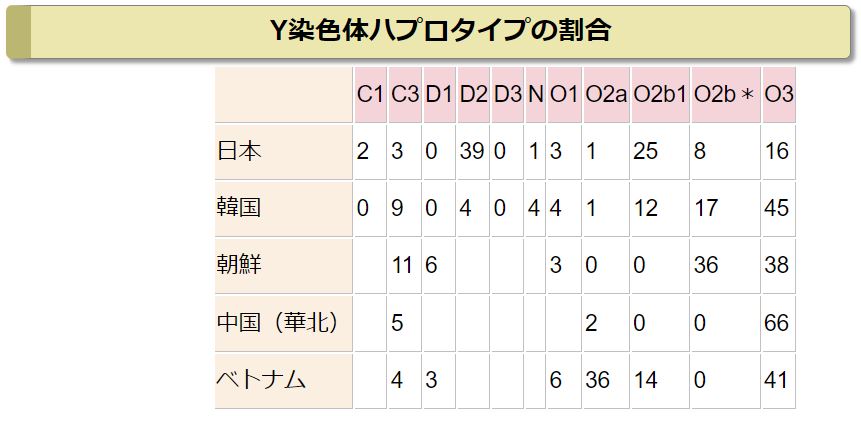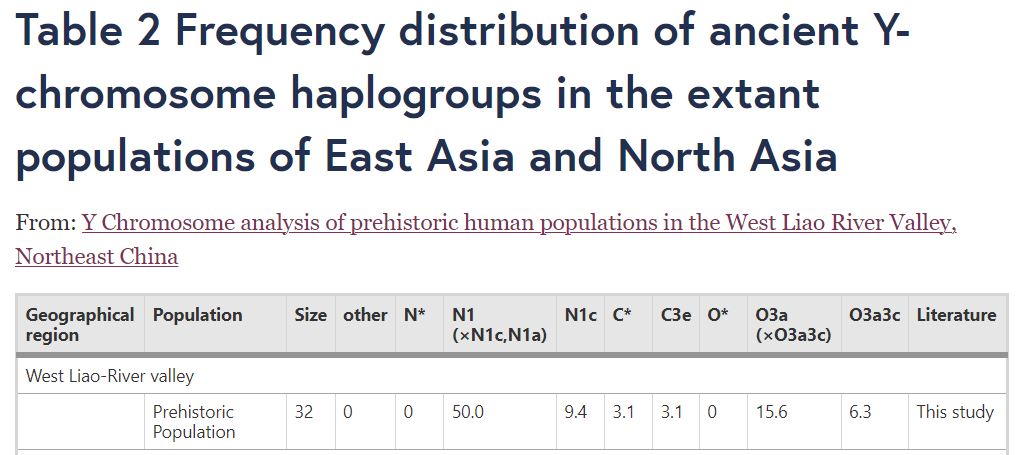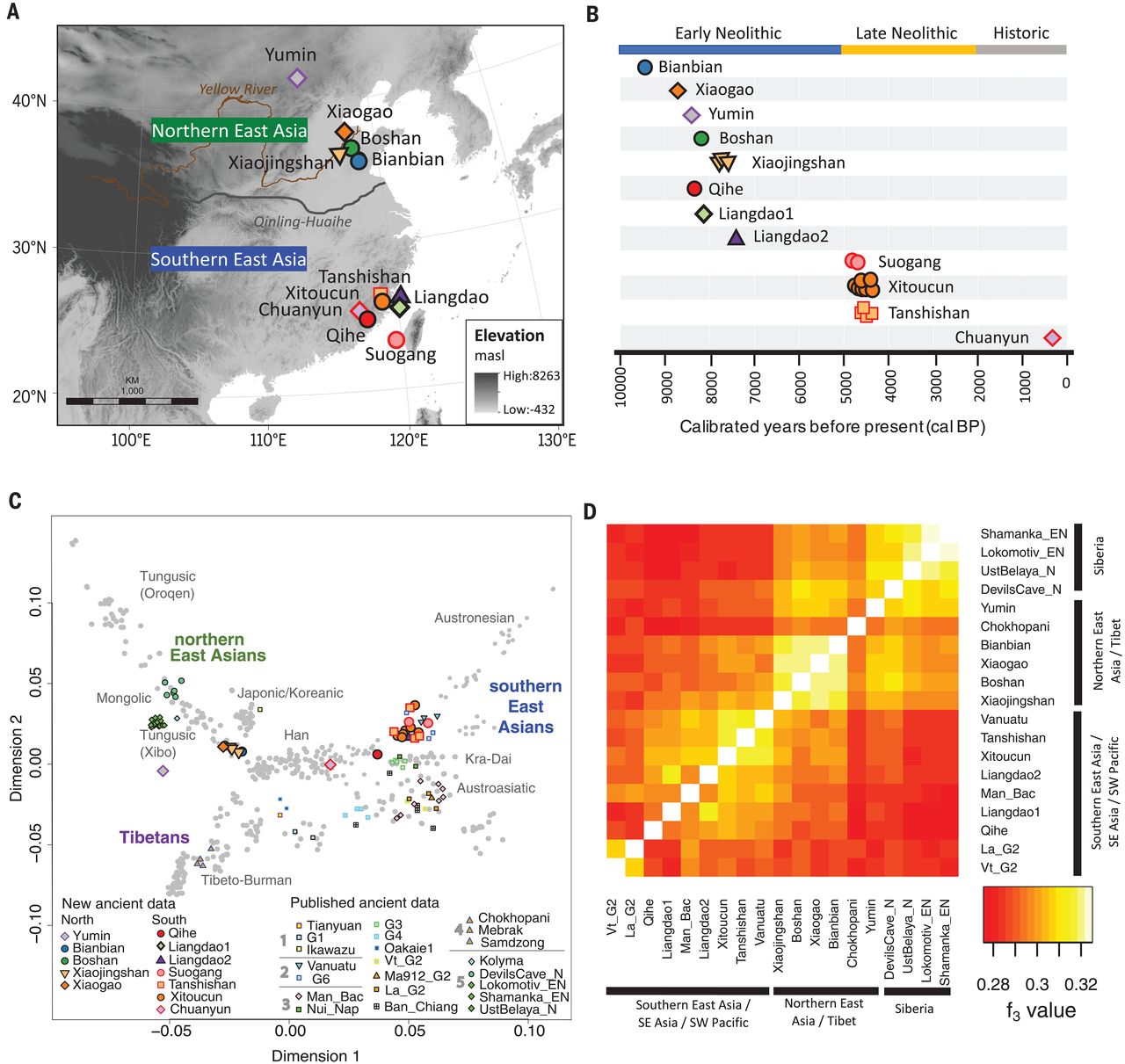北朝鮮のタバコの吸い殻によるY染色体ハプログループの推定 [ゲノム解析で古代史]
自分のための備忘録です。
北朝鮮のタバコの吸殻からY染色体のハプログループを推定した研究があります。
Jeong, KS., Shin, H., Lee, SJ. et al. Genetic characteristics of Y-chromosome short tandem repeat haplotypes from cigarette butt samples presumed to be smoked by North Korean men. Genes Genom 40, 819–824 (2018). https://doi.org/10.1007/s13258-018-0701-5
結論として、"For the 16 Y-filer loci and eight minimal loci, respectively 90.9 and 82.6% of the matched haplotypes were estimated to belong to haplogroup O, representing the Southeast and East Asian type."とあり、ハプログループOが82.6%または90.9%との推定です。
また、"Despite the separation between North and South Korea for 70 years, they can still be considered a single genetic population, based on Y-STR haplotypes."ともあり、「70年もの間、南北朝鮮が分離していたにもかかわらず、Y-STRハプロタイプに基づくと、両者は依然として単一の遺伝的集団とみなすことができる。」とのこと。
なお、元のソースが不明ですが、このサイトによると、ハプログループOは83%となっています。

↓は、古代の西遼河(旧・満州)のY染色体の分析です。
Cui, Y., Li, H., Ning, C. et al. Y Chromosome analysis of prehistoric human populations in the West Liao River Valley, Northeast China. BMC Evol Biol 13, 216 (2013). https://doi.org/10.1186/1471-2148-13-216
結論として、ハプログループNが62.5%で、現在中国で主流のO2(この表は旧表記のためO3)は21.9%で、弥生人・現代日本人に多いO1b2(同O2)は見つかりませんでした。

紅山文化は日本の縄文人と交流があったとされますが、縄文人で主流のD1a2aは見つかりませんでした。
別の論文、
Melinda A. Yang et al. Ancient DNA indicates human population shifts and admixture in northern and southern China. Science 369,282-288(2020).DOI:10.1126/science.aba0909
では、古代中国のDNAの主成分分析を行いました。
日本人は、黄河下流の人々に近いのですが、別のグループのようです。
下の図のCを見ると、伊川津の縄文人と現代日本・韓国人は極めて近く、やはり縄文人がそのまま弥生人になったと考えるのが一番素直なようです。

なお、伊川津の縄文人2体については、ミトコンドリアのハプログループはどちらもM7a1aですが、親子ではないとのことです。
Complete mitochondrial genome sequencing reveals double-buried Jomon individuals excavated from the Ikawazu shell-mound site were not in a mother–child relationship
Anthropological Science 2022
https://www.jstage.jst.go.jp/article/ase/advpub/0/advpub_220129/_pdf/-char/ja
北朝鮮のタバコの吸殻からY染色体のハプログループを推定した研究があります。
Jeong, KS., Shin, H., Lee, SJ. et al. Genetic characteristics of Y-chromosome short tandem repeat haplotypes from cigarette butt samples presumed to be smoked by North Korean men. Genes Genom 40, 819–824 (2018). https://doi.org/10.1007/s13258-018-0701-5
結論として、"For the 16 Y-filer loci and eight minimal loci, respectively 90.9 and 82.6% of the matched haplotypes were estimated to belong to haplogroup O, representing the Southeast and East Asian type."とあり、ハプログループOが82.6%または90.9%との推定です。
また、"Despite the separation between North and South Korea for 70 years, they can still be considered a single genetic population, based on Y-STR haplotypes."ともあり、「70年もの間、南北朝鮮が分離していたにもかかわらず、Y-STRハプロタイプに基づくと、両者は依然として単一の遺伝的集団とみなすことができる。」とのこと。
なお、元のソースが不明ですが、このサイトによると、ハプログループOは83%となっています。
↓は、古代の西遼河(旧・満州)のY染色体の分析です。
Cui, Y., Li, H., Ning, C. et al. Y Chromosome analysis of prehistoric human populations in the West Liao River Valley, Northeast China. BMC Evol Biol 13, 216 (2013). https://doi.org/10.1186/1471-2148-13-216
結論として、ハプログループNが62.5%で、現在中国で主流のO2(この表は旧表記のためO3)は21.9%で、弥生人・現代日本人に多いO1b2(同O2)は見つかりませんでした。
紅山文化は日本の縄文人と交流があったとされますが、縄文人で主流のD1a2aは見つかりませんでした。
別の論文、
Melinda A. Yang et al. Ancient DNA indicates human population shifts and admixture in northern and southern China. Science 369,282-288(2020).DOI:10.1126/science.aba0909
では、古代中国のDNAの主成分分析を行いました。
日本人は、黄河下流の人々に近いのですが、別のグループのようです。
下の図のCを見ると、伊川津の縄文人と現代日本・韓国人は極めて近く、やはり縄文人がそのまま弥生人になったと考えるのが一番素直なようです。

なお、伊川津の縄文人2体については、ミトコンドリアのハプログループはどちらもM7a1aですが、親子ではないとのことです。
Complete mitochondrial genome sequencing reveals double-buried Jomon individuals excavated from the Ikawazu shell-mound site were not in a mother–child relationship
Anthropological Science 2022
https://www.jstage.jst.go.jp/article/ase/advpub/0/advpub_220129/_pdf/-char/ja
2023-09-10 08:16
コメント(0)




コメント 0